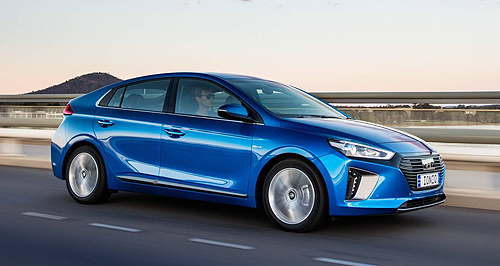Future models - Hyundai - IONIQ - HybridHyundai goes fleet first for IoniqHybrid theory: Hyundai has offered the Ioniq Hybrid to some of its biggest fleet customers, but all three powertrain options will hit Australian shores in the third quarter of the year. Ioniq Hybrid a hit with fleets as Hyundai plans full range launch in Q319 Mar 2018 HYUNDAI Motor Company Australia (HMCA) has delivered the first examples of its Ioniq petrol-electric hybrid liftback to key fleet customers ahead of the retail rollout of the full Ioniq line-up – including hybrid, plug-in hybrid and a fully electric version – in the third quarter of the year. The South Korean car-maker says there are a total of 70 vehicles on the road in Australia as part of the fleet program, including 34 with the Australian Red Cross, one with the Australian Red Cross Blood Service, 28 with the South Australian government and seven with Northern Alliance Victoria. Hyundai is not talking specifics on its fleet pricing for the early adopters, but GoAuto believes that recommended retail pricing for the hybrid version will kick off from the low-$30,000 mark, while the EV could land from about $45,000, before on-road costs when they launch later this year. If it comes to market with that pricing, the Ioniq EV looks set to undercut Nissan’s new-generation Leaf that is expected to land from about $50,000, while Renault’s tiny Zoe EV starts from about $45,000. Timing wise, the Ioniq range is also expected to hit the market before the new Leaf. HMCA general manager of external affairs Bill Thomas told GoAuto that the company decided to offer the Ioniq Hybrid to some of its fleet customers ahead of a wider retail rollout to get detailed user feedback. “We just had the opportunity to import some of the Hybrid models and we thought we would do it and place them with some of our favourite fleet customers for a favourable rate,” he said. “It is a good way to get an idea of how people might use them in fleet use. And it’s a useful thing for us to place the vehicles and get some feedback on them. “Some of them are getting 900km out of a tank with very mixed usage which is great. It’s just a nice opportunity for us to get cars on the road.” HMCA manager of future mobility and government relations Scott Nargar said it made sense to roll out the Ioniq to fleet operators first as some fleet customers had carbon targets or were looking to reduce their overall emissions. Mr Nargar said while other manufacturers have offered electrified powertrain technology for longer than Hyundai, the Korean car-maker would be the only brand to sell a full suite of eco-friendly models in Australia. “Hybrid has been around for a long time and we know Toyota has dominated that technology. But we need to have viable options in the market against their product,” he said. “Also, we want to make sure we are leading the way in Australia with zero emissions and if you look around there won’t be any other manufacturer that is offering hydrogen fuel-cell vehicles, hybrid vehicles, plug-in electric vehicles and EVs into market, so it is an area where Hyundai is focused very heavily on the future.” As well as the Ioniq, Hyundai is expected to introduce the Kona EV crossover that was revealed at the Geneva motor show, and the Nexo hydrogen fuel-cell-powered SUV to the Australian market in the coming years. This is part of Hyundai Motor’s plan to launch 38 eco models globally by 2025. Mr Nargar said representatives from Hyundai have spent time with various governments to encourage them to offer more eco-friendly models in their fleets, but he added that it did not need to be a dramatic shift away from internal combustion vehicles straight away. “Hyundai has spent a bit of time with different governments in different states making sure they are aware that that the technology is available, it’s practical, it is affordable and viable. We are not saying to a government ‘you need to go through and replace 100 per cent or 50 per cent of your fleet’ – look at two or three per cent of your fleet to start with. Start the transition.” While a number of car-makers had called for the government to offer financial incentives to encourage the uptake of green cars, Mr Nargar said Hyundai was not pushing for this, however the company would like to see a greater focus on EV charging infrastructure in Australia. “When it comes to incentives, as a car manufacturer we don’t want anything, we don’t need anything and we shouldn’t be asking for it. But I think (we need to) introduce the consumers into the technology... but also infrastructure, that is really the key. “There are probably two or three companies looking at mass deployment of infrastructure around Australia and they are approaching car manufacturers and governments and commercial partners to try and roll these out. And that is really what is needed. To say to consumers out there that there is infrastructure available when you are away from home or the office. We do know that most people charge up at home, but the biggest barrier to purchase is knowing that there is a piece of infrastructure out there I can charge up.” Under the bonnet of the Ioniq Hybrid is a 1.6-litre four-cylinder Kappa Euro 5 petrol engine producing 77kW and 147Nm, teamed with a 32kW/170Nm electric motor on the front axle as well as a 1.56kWh and 240V lithium-ion battery. It is driven via the front wheels through a six-speed dual-clutch automatic transmission and offers a total system output of 104kW/265Nm. Fuel use is rated at 3.9 litres per 100km on the official combined cycle and it emits 92g/km of CO2. The Ioniq’s most obvious rival is the Toyota Prius hybrid, which offers up a combined output of 90kW/163Nm from its 1.8-litre petrol engine and two electric motors, with fuel consumption of 3.4L/100km and CO2 emissions of 80g/km edging out the Ioniq. Each Ioniq variant will benefit from a local suspension and steering tune from Hyundai’s Australian calibration team to ensure the ride and handling characteristics match Australian conditions. While Hyundai is yet to announce any details about the full range, it is likely that each powertrain will be offered with a choice of two model grades – Elite and Premium. The Ioniq Hybrid Premium that the fleets are driving comes standard with a 7.0-inch TFT colour instrument cluster, an 8.0-inch touchscreen display with satellite navigation and Suna live traffic updates, Bluetooth connectivity and Apple CarPlay and Android Auto, DAB+ digital radio, auxiliary and USB inputs and an Infinity eight-speaker stereo system. It also gets leather-appointed seats, steering wheel and gear knob, a 10-way power adjustable driver’s seat, a wireless charging pad, sunroof, auto-dimming rearview mirror, dual-zone climate control air-con, heated and ventilated front seats, bi-Xenon headlights, LED foglights and daytime running lightsSafety wise it features autonomous emergency braking, blind spot detection, forward collision warning, lane change assist, lane keep assist, rear cross-traffic alert, adaptive cruise control, front and rear parking sensors, a reversing camera, a tyre pressure monitoring system and Isofix child restraint anchors.  Read more8th of March 2018  Hyundai takes the green busHydrogen FCEV and battery-electric buses ramp up at Hyundai as diesel, CNG wane28th of February 2018  Geneva show: Hyundai plugs-in with Kona ElectricAustralian arrival firming for Hyundai Kona Electric following Geneva show debut9th of January 2018  CES: Hyundai dubs FCEV NexoHyundai Nexo SUV to feature advanced driver-assist systems, 800km driving range24th of February 2017  First drive: Hands up for all three Hyundai IoniqsAustralian Hyundai Ioniq launch could be held back for full range introduction21st of February 2017  First autonomous Hyundai coming in 2020Hyundai maps path to full level-four self-driving production cars by 2030 |
Click to shareHyundai modelsResearch Hyundai Motor industry news |


























Facebook Twitter Instagram